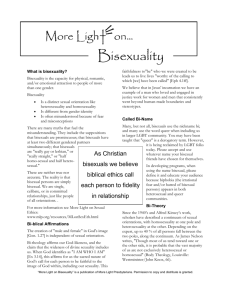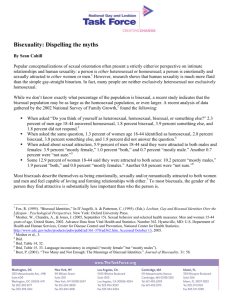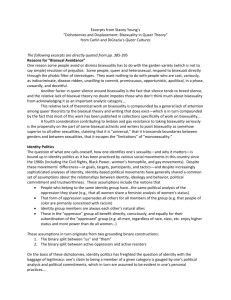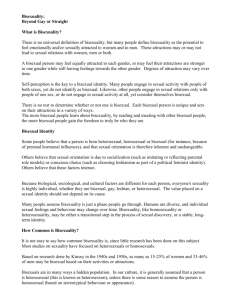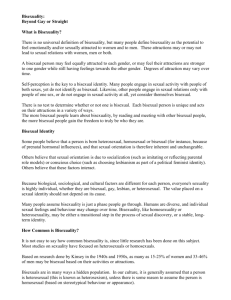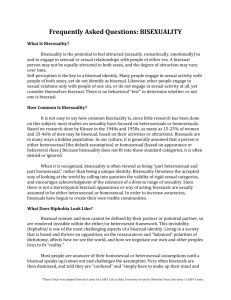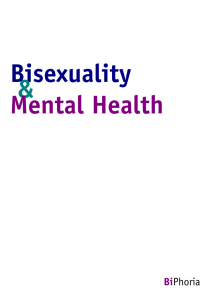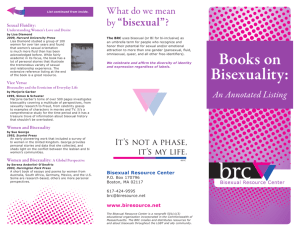GROWING UP BISEXUAL
advertisement
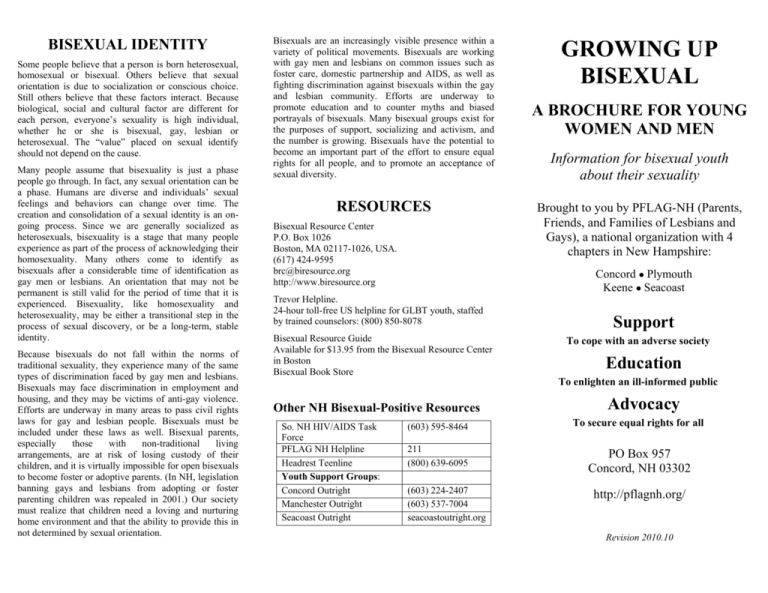
BISEXUAL IDENTITY Some people believe that a person is born heterosexual, homosexual or bisexual. Others believe that sexual orientation is due to socialization or conscious choice. Still others believe that these factors interact. Because biological, social and cultural factor are different for each person, everyone’s sexuality is high individual, whether he or she is bisexual, gay, lesbian or heterosexual. The “value” placed on sexual identify should not depend on the cause. Many people assume that bisexuality is just a phase people go through. In fact, any sexual orientation can be a phase. Humans are diverse and individuals’ sexual feelings and behaviors can change over time. The creation and consolidation of a sexual identity is an ongoing process. Since we are generally socialized as heterosexuals, bisexuality is a stage that many people experience as part of the process of acknowledging their homosexuality. Many others come to identify as bisexuals after a considerable time of identification as gay men or lesbians. An orientation that may not be permanent is still valid for the period of time that it is experienced. Bisexuality, like homosexuality and heterosexuality, may be either a transitional step in the process of sexual discovery, or be a long-term, stable identity. Because bisexuals do not fall within the norms of traditional sexuality, they experience many of the same types of discrimination faced by gay men and lesbians. Bisexuals may face discrimination in employment and housing, and they may be victims of anti-gay violence. Efforts are underway in many areas to pass civil rights laws for gay and lesbian people. Bisexuals must be included under these laws as well. Bisexual parents, especially those with non-traditional living arrangements, are at risk of losing custody of their children, and it is virtually impossible for open bisexuals to become foster or adoptive parents. (In NH, legislation banning gays and lesbians from adopting or foster parenting children was repealed in 2001.) Our society must realize that children need a loving and nurturing home environment and that the ability to provide this in not determined by sexual orientation. Bisexuals are an increasingly visible presence within a variety of political movements. Bisexuals are working with gay men and lesbians on common issues such as foster care, domestic partnership and AIDS, as well as fighting discrimination against bisexuals within the gay and lesbian community. Efforts are underway to promote education and to counter myths and biased portrayals of bisexuals. Many bisexual groups exist for the purposes of support, socializing and activism, and the number is growing. Bisexuals have the potential to become an important part of the effort to ensure equal rights for all people, and to promote an acceptance of sexual diversity. RESOURCES Bisexual Resource Center P.O. Box 1026 Boston, MA 02117-1026, USA. (617) 424-9595 brc@biresource.org http://www.biresource.org Trevor Helpline. 24-hour toll-free US helpline for GLBT youth, staffed by trained counselors: (800) 850-8078 Bisexual Resource Guide Available for $13.95 from the Bisexual Resource Center in Boston Bisexual Book Store GROWING UP BISEXUAL A BROCHURE FOR YOUNG WOMEN AND MEN Information for bisexual youth about their sexuality Brought to you by PFLAG-NH (Parents, Friends, and Families of Lesbians and Gays), a national organization with 4 chapters in New Hampshire: Concord ● Plymouth Keene ● Seacoast Support To cope with an adverse society Education To enlighten an ill-informed public Other NH Bisexual-Positive Resources So. NH HIV/AIDS Task Force PFLAG NH Helpline Headrest Teenline Youth Support Groups: Concord Outright Manchester Outright Seacoast Outright Advocacy (603) 595-8464 To secure equal rights for all 211 (800) 639-6095 PO Box 957 Concord, NH 03302 (603) 224-2407 (603) 537-7004 seacoastoutright.org http://pflagnh.org/ Revision 2010.10 WHAT IS BISEXUALITY? BISEXUAL RELATIONSHIPS Bisexuality is the potential to feel sexually attracted to and to engage in sensual or sexual relationships with people of either sex. A bisexual person may not be equally attracted to both sexes; the degree of attraction may also vary over time. Bisexuals, like other people, have a wide variety of relationship styles. Contrary to common myth, a bisexual person does not need to be simultaneously sexually involved with both a man and a woman. In fact, some people who identify as bisexual never engage in sexual activity with another person. As is the case for heterosexuals and gay men and lesbians, attraction does not involve acting on every desire. Just like heterosexuals and gay people, many bisexuals choose to be active with one partner only and have long-term, monogamous relationships. Self-perception is the key to bisexual identity. Many people engage in sexual activity with people of both sexes, yet do not self-identify as bisexual. Likewise, other people engage in sexual relations only with people of one sex or do not engage in sexual activity at all, yet consider themselves bisexual. There is no behavioural “test” to determine whether or not one is bisexual. HOW COMMON IS BISEXUALITY? It is not easy to say how common bisexuality is, since little research has been done on this subject. Most studies on sexuality have focused on heterosexuals or homosexuals. Based on research done by Kinsey in the 1940’s and 1950’s, as many as 15-25 percent of women and 33-64 percent of men may be bisexual based on their activities or attractions. Bisexuals are in many ways a hidden population. In our culture, it is generally assumed that a person is either heterosexual (the default assumption) or homosexual (based on appearance or behavior clues). Because bisexuality does not fit into these standard categories, it tends to be denied or ignored. When it is recognized, bisexuality is often viewed as being “part heterosexual and part homosexual”, rather than being a unique identity. Bisexuality threatens the accepted way of looking at the world by calling into question the validity of rigid sexual categories and encourages acknowledgement of the existence of a diverse range of sexuality. Since there is not a stereotypical bisexual appearance or way of acting, bisexuals are usually assumed to be either heterosexual or homosexual. In order to increase awareness, bisexuals have begun to create their own visible communities. HOW DO WE LEARN TO LIKE OURSELVES? All people have a right to feel good about themselves. Developing self-esteem is very important to young people. It’s hard for bisexual, gay and lesbian youth to do so because many of the people around us believe that we’re sick, perverted and destined to live unhappy lives. When we feel we have to hide who we really are, it can make us feel like harming ourselves through drugs, alcohol, or suicide. We may feel isolated, fearful and depressed, especially if we have had no one to talk to about being bisexual. More and more we as young bisexuals, are learning to like who we are. More and more prominent psychologists and researchers are recognizing the capacity of many individuals to love, and be sexually attracted to, members of both genders. Remember, just as it’s normal and natural to be heterosexual, its normal and natural to be bisexual. SEXUALLY TRANSMITTED DISEASES (STDs) AND BISEXUALITY Like everyone who is sexually active, individuals who are bisexually active are at risk for a number of sexually transmitted diseases unless they are careful and use some kind of barrier protection. If bisexual women or men have unprotected intercourse or oral sex (without a condom or dam) penile secretions, vaginal fluids or blood that contain bacterial or viral infections may enter their body. These fluids can contain infections like Gonorrhea, Syphilis, Genital Warts, Chlamydia or HIV, the virus that causes AIDS. Some of these diseases cause symptoms immediately, other cause no obvious symptoms. If you have been sexually active, it is a good idea to get checked for STD’s and HIV at a Public Health or Family Planning Clinic. The AIDS epidemic has had significant impact on individuals who are bisexually active. Bisexual men are often blamed for HIV infection in women as well as men. Bisexual women may be blamed for infecting lesbian women with HIV. However, it is the specific sexual activity that determines who gets infected with HIV and not the sex of the partner. To find out more about STD’s or HIV and AIDS, call your local AIDS organization (Southern NH HIV/AIDS Task Force (603) 595-8464 or the National AIDS Hotline 1-800-342-AIDS/2437. This brochure was adapted by the Southern NH HIV / AIDS Task Force, based on a brochure prepared by the Bisexual Committee Engaging in Politics (BICEP), under the auspices of the East Coast Bisexuals Network. Information from a brochure written by Kevin Cranston and Cooper Thompson, with help from members of BAGLY, Boston Area Gay and Lesbian Youth and produced and distributed by the Campaign to End Homophobia.
